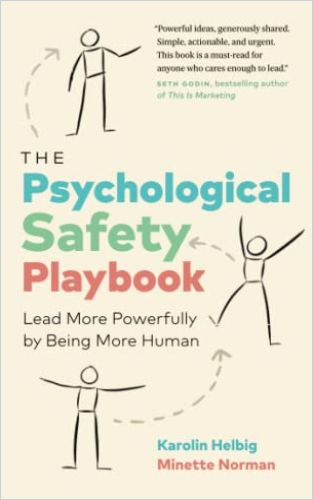“It’s All About Embedding These Practices Into Existing Routines”

Minette and Karolin, a few months ago, I had an interview with the Swiss business strategist Alex Osterwalder that touched on psychological safety. During our conversation, Alex elaborated on the concept and his journey. At one point, I expressed my belief that psychological safety seems like common sense, something everyone should be familiar with. He chuckled but then turned serious, stating, “It might be common sense, but it’s not common practice.” Since then, I’ve made it a point to ask every expert I talk to about psychological safety why this gap exists. Do you have any insights on this?
Karolin Helbig: While widely recognized as a concept, psychological safety often falls short in practice. As someone with a background in biology, I believe it is because it goes against our instincts. Our innate wiring as humans leans towards self-protection and risk aversion, not vulnerability. To foster psychological safety, we need to overcome this natural tendency. It’s not instinctive to open up with vulnerability or actively listen without interjecting our viewpoints. Likewise, refraining from immediate reactions and choosing thoughtful responses don’t come naturally. When something goes wrong, our instinct is to assign blame rather than embrace curiosity and seek to learn from the situation. Creating psychological safety requires us to go against our instincts, which can be challenging.
Minette Norman: I believe psychological safety remains a challenge because it has been well understood for decades that it’s essential, yet it’s rarely effectively implemented in workplaces. In my 30 years of experience in the business world, I encountered very few environments that truly embodied psychological safety. The problem lies in the gap between recognizing its importance and knowing how to put it into practice. Many people think they can declare a space safe and expect it to be so, but this doesn’t work. You must invest in day-to-day practices that consistently demonstrate safety so people genuinely feel secure to speak up. This gap between understanding the “why” and knowing the “how” motivated us to work on this book.

Your book addresses this gap effectively, filling a much-needed void. I often wondered why there’s so much theoretical discussion on psychological safety, yet few concrete practices are shared.
Karolin: I think that our traditional leadership models – and all the textbook classics used in business schools around them – continue to influence the business world today and also hinder psychological safety.
The prevailing mindset among leaders is that they must always appear strong, have all the answers, and avoid showing vulnerability. Shifting away from this traditional leadership mindset is crucial in fostering psychological safety.
Have you noticed significant disparities in adopting psychological safety practices in the US versus Germany or Europe? Given that we’re having this discussion with an expert from the US and an expert from Germany, I’d like to explore whether you’ve observed any differences in the prevalence of psychological safety in workplaces between these regions.
Minette: I don’t believe there are inherent differences between countries regarding psychological safety. Instead, it’s highly team-specific and often depends on the leadership within those teams. While I did encounter psychological safety in isolated pockets during my 30 years in the business world, it wasn’t a consistent presence. However, one aspect to consider is that the experience of psychological safety can differ across cultures due to cultural nuances.
For example?
Minette: Cultures like the US and Germany may encourage more outspokenness compared to some Asian cultures, which may have more hierarchical structures and discomfort with speaking up against authority. So, when working globally, creating a safe environment becomes a more complex challenge, as you need to ensure that individuals from diverse cultural backgrounds feel equally comfortable sharing their thoughts and ideas.
Karolin: Different teams can even exhibit distinct “mini-cultures” with varying levels of psychological safety. During my time at McKinsey, I encountered surprising and sometimes unexpected cultural dynamics among clients within Germany and the Middle East. This highlights that psychological safety is not solely a regional issue but a nuanced aspect of team and organizational culture.
I was referring to the overall shift from theory to practical implementation. Specifically, I’m interested in whether you’ve observed more teams embracing and implementing the concept in recent years. While there may be varying degrees of psychological safety, there’s a trend toward increased adoption and application of the idea.
Karolin: There certainly is. And given the rapid pace of change in our work environment, it’s unsurprising because psychological safety is becoming increasingly vital. The nature and speed of change are unprecedented, but as humans, we tend to think linearly – even though technological progress is exponential: Skills are becoming obsolete every 18 months. In this context, psychological safety is critical for fostering innovation and adapting to the fast-paced work world. I would say it’s essential for thriving in this accelerated “white water” environment.
Minette: Recent studies second Karolin’s findings. They may not explicitly focus on psychological safety when exploring employee mental health, well-being, and engagement, but they indicate a strong correlation between psychological safety and positive performance outcomes.
Can you give an example?
Minette: Sure. The recent McKinsey and LeanIn Women in the Workplace survey highlights how lower levels of psychological safety negatively affect work performance and retention, particularly for women of color.
While there might not be studies directly linking psychological safety to specific results, it’s safe to say that there is a significant connection between psychological safety and various success factors.
Again, I think it’s essential to address the seemingly counterintuitive aspect of psychological safety for many leaders: While there’s a need to speed up processes and innovate rapidly, practices like active listening, effective communication, and emotional regulation may seem time-consuming.
Many leaders report being overwhelmed with transformation management tasks anyway.
Minette: That is undoubtedly true. Yet, to leaders who feel overwhelmed and argue that they can’t afford to invest time in these practices, my response is that you’ll never find the time if you treat these as nice-to-have extras. They are not. They are business imperatives. If you want to drive innovation and get the best performance from your workforce, you must integrate these practices into every interaction and not treat them as separate tasks. It doesn’t mean long, drawn-out sessions; even short exchanges can be more effective when you ensure everyone’s voice is heard and valued. Even in quick decision-making situations, you can encourage different perspectives by approaching discussions with curiosity rather than defensiveness. So, it’s all about embedding these practices into existing routines, such as meetings and conversations.
Karolin: Leaders should recognize they are not alone in navigating the white-water rapids of change. They are in the kayak with their team, and their team’s effectiveness is essential. Neglecting team dynamics and communication can jeopardize success.
From that perspective, investing time in fostering psychological safety and teamwork is not an extra burden; it’s a prerequisite for navigating the challenges effectively by ensuring that the boat does not sink but moves safely and faster.
That’s a powerful image. But where should someone new to this concept begin to see the tangible effects that motivate them to continue? Acknowledging that it requires effort and perseverance, what initial steps do you suggest for leaders to witness the benefits of psychological safety?
Minette: We emphasize the importance of asking, “What am I missing?” in discussions. This is the first recommendation we make in the book because it’s simple yet incredibly effective. By creating an environment where people feel comfortable sharing their ideas and leaders actively listen without defensiveness, you’ll begin to realize the power of diverse perspectives. This simple practice can lead to identifying critical business risks or opportunities that might have otherwise been overlooked. It’s a straightforward and potent starting point that can profoundly impact.
Karolin: Most of the 25 simple strategies in the book won’t add significant extra time to your schedule. These strategies involve doing what you’re already doing in a slightly different way. I advise browsing them and picking the strategies that resonate with you. You don’t have to implement all of them at once. Start with one that aligns with your preferences and circumstances.
Even a tiny shift can produce significant results.
For example, a German automotive company conducted a pilot using the question, “What am I missing?” during team meetings and saw a remarkable transformation in how team members engaged and spoke up. Never underestimate the impact of small changes!
I love the “inclusion booster” idea in your book, which can naturally integrate active listening and participation by having a moderator from your team keep an eye on speaking and silence during meetings, for example. Can you highlight some of the book’s favorite inclusion tips and practices?
Minette: With a focus on meetings, one effective practice is implementing a turn-taking mechanism where no one speaks twice until everyone speaks once. This ensures that all voices are heard and respected, creating a more inclusive atmosphere. Additionally, using online whiteboards can allow everyone to share their ideas and perspectives, fostering a sense of being heard and valued. The key takeaway is that inclusivity is vital for all voices to be acknowledged and respected, ultimately leading to better decision-making and outcomes.
Karolin: My favorite inclusion practice is shifting from a “yes, but” mindset to a “yes, and” attitude. Our natural response is often to critique or dismiss ideas. By shifting to an appreciative mindset, we can build on each other’s contributions. Instead of focusing on what doesn’t work, we recognize the value in each idea and aim to improve it collectively. This shift enhances the quality of our interactions, builds upon existing concepts, and fosters a more inclusive environment.
While The Psychological Safety Playbook is primarily directed at leaders due to their significant influence on team dynamics, leaders can also be barriers to implementing psychological safety. What if a leader is unaware of or uninterested in this concept or even neglects it? Is there anything team members can do from the bottom up to foster a culture of psychological safety, perhaps by building alliances or attempting to convince their leader to embrace these principles?
Karolin: Change certainly can start at the grassroots level. While leaders play a crucial role, as you mentioned, everyone in the team contributes to psychological safety. How team members interact with each other, respond to ideas, and engage in meetings shapes the overall psychological safety within the group. Small steps like changing your reactions to colleagues’ ideas, avoiding eye-rolling, and focusing on the positive aspects of suggestions can influence team dynamics positively.
Teams can initiate these changes themselves, even without leader involvement. Yet, leaders, too, appreciate being treated as fellow human beings – so inviting them to join a different, more inclusive game can be effective.
Start with small changes in how you interact, and there’s a chance your leader may naturally integrate into this evolving culture of psychological safety. While it’s not a guaranteed recipe, it can influence leaders positively over time.
Minette: Allyship can play a significant role here. For instance, if someone is consistently interrupted during meetings, colleagues can step in and say, “Hold on a second. Karolin didn’t get to finish.” This collaborative approach can gradually shift group dynamics and draw the leader’s attention when the team works together in a more supportive rather than adversarial manner. When you start to witness such positive changes, I also believe you must communicate these improvements to the leader. They might not be aware of the subtle shifts until you highlight them. Sharing these points helps in demonstrating the progress that’s being made.
About the Authors
Karolin Helbig is a mind-set coach for executives. Minette Norman is a leadership consultant and former Silicon Valley executive who works with companies to build more inclusive cultures.






